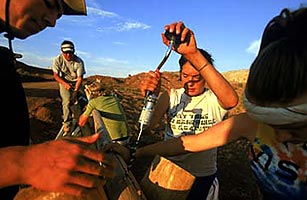
A SWELL EFFORT
Members of the Sierra Student Coalition, the student-run arm of the Sierra Club, took a trip to San Rafael Swell, Utah, to aid in wilderness preservation efforts
For idealistic young people determined to save the environment, today's challenges seem far more daunting than those their parents faced. When Woodstock youth rallied on the first Earth Day in 1970, the issues were pretty straightforward: clean air, clean water and protection for furry creatures. And when the U.S. Congress enacted such tough laws as the Clean Air Act and the Endangered Species Act, the young activists could raise their fists in triumph. How times have changed. These days, environmental problems are global and discouragingly complex. Topics like climate change and animal protection have become tangled up with issues of poverty, trade and foreign debt. Which explains why some of the more radical of today's young environmentalists were among the angry throngs at the infamous 1999 World Trade Organization meeting in Seattle and the 2001 Group of Eight gathering in Genoa. Unfortunately, to most observers, those violence-marred demonstrations seemed more like confused mob scenes than coherent protests. The plethora of complaints was too bewildering. Why, for example, were kids in turtle suits parading down the streets of Seattle? Because the WTO had decided that a U.S.-mandated device designed to keep fishermen from accidentally killing turtles was an illegal restraint on international trade.